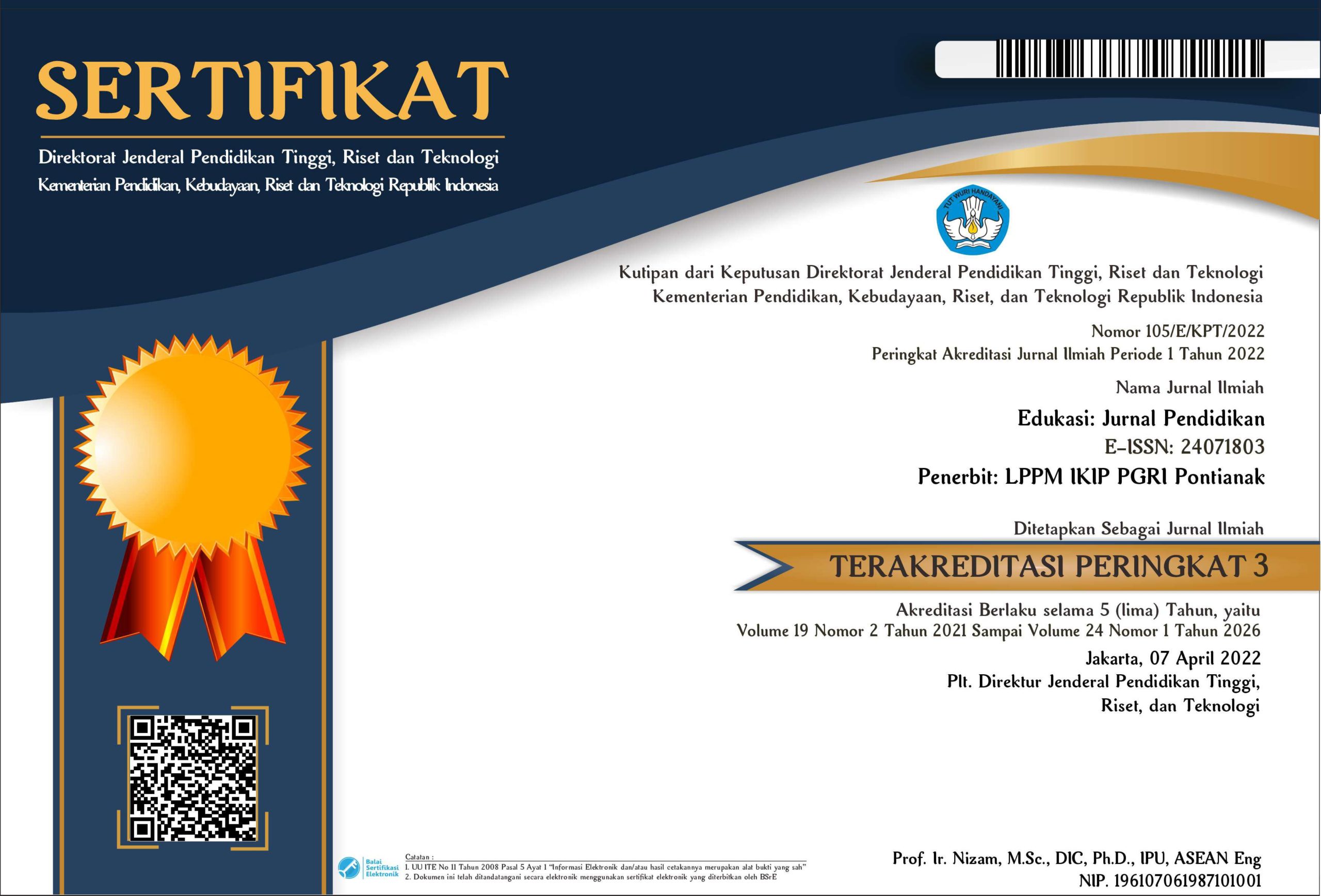Perancangan Pembelajaran E-Learning Bahasa Inggris untuk Pemula Berbasis Multimedia
DOI:
https://doi.org/10.31571/edukasi.v18i1.1601Keywords:
analisis, perancangan, e-learning, multimedia, analysis, designAbstract
Abstrak
Tujuan penelitian adalah merancang aplikasi pembelajaran e-learning bahasa Inggris berbasis multimedia dengan menggabungkan konsep yang terdiri dari teks, gambar, animasi, dan video. Subjek penelitian adalah siswa SMA kelas X. Dalam mengimplementasikan aplikasi pembelajaran, peneliti menggunakan Moodle. Metode pengembangan sistem menggunakan System Development Live Cycle (SDLC). Untuk analisis dan perancangan sistem menggunakan metode Unified Modelling Language (UML). Peneliti berhasil merancang aplikasi pembelajaran yang dapat dijadikan sebagai media pembelajaran Bahasa Inggris untuk tingkat pemula dengan tema learning by doing. Aplikasi pembelajaran yang dirancang diharapkan dapat membantu meningkatkan proses belajar bahasa Inggris terutama dalam membaca, menghapal, dan mengucapkan kosakata.
Â
Abstract
The purpose of the research was to design the e-learning of English multimedia-based application by combining concepts consisting of text, images, animation, and video. The research subjects were high school students in class X. In implementing the learning application, researchers used Moodle. The system development method uses the System Development Live Cycle (SDLC). For system analysis and design using the Unified Modeling Language (UML) method. Researchers succeeded in designing learning applications that can be used as a medium of learning English for the beginner level with the theme of learning by doing. Learning applications that are designed are expected to help improve the process of learning English, especially in reading, memorizing, and speaking vocabulary.
Downloads
References
Ampa, A. T., Rasyid, M. A., Rahman, M. A., Haryanto, Basri, M. 2013. The Implementation of Multimedia Learning Materials in Teaching English Speaking Skills. International Journal of English Language Education, 1(3): 293-304.
Arpan, M. & Sadikin. 2020. Media Pembelajaran Interaktif Perangkat Keras Komputer. INVOTEK: Jurnal Inovasi Vokasional dan Teknologi, 20(2): 43-50.
Arpan, M., Salaman, Budiman, R. D. A., Ambyar, & Wakhinudin. 2020. Student Learning Outcomes Using Drill and Practice Type of Computer Assisted Instruction. International Journal of Scientific & Technology Research, 9(04): 1433-1436.
Brett, P. L. 1995. Multimedia for Listening Comprehension : The Design of A Multimedia-Based Resource for Developing Listening. Elsevier Science, 23(1): 77–85.
Dharmayanti, W. & Oktarika, D. 2019. Pengembangan Media Pembelajaran Berbasis Multimedia Interaktif untuk Guru IPA di Sekolah Menengah Pertama. Jurnal Pendidikan Informatika dan Sains, 8(1): 41-51.
Diyyab, E. A. 2014. Using a Multimedia-Based Program for Developing Student Teachers’ EFL Speaking Fluency Skills. Journal of Faculty of Eduction, 25(99): 1-28.
Gilakjani, A. P. 2012. The Significant Role of Multimedia in Motivating EFL Learners Interest in English Language Learning. I.J. Modern Education and Computer Science, 4(5): 57-66.
Kim, D., Kim, D. J., & Whang, W. H. 2013. Cognitive Synergy in Multimedia Learning. International Education Studies, 6(4): 76-84.
Komalasari, K. 2019. Living Values Based Interactive Multimedia in Civic Education Learning. International Journal of Instruction, 12(1): 113-26.
Muhson, A. 2010. Pengembangan Media Pembelajaran Berbasis Teknologi Informasi. Jurnal Pendidikan Akuntansi Indonesia, 8(2): 1-10.
Mulyadi. R. & Purnama, F. 2019. Pengembangan E-Learning Mata Pelajaran Teknologi Layanan Jaringan. Joisie, 3(2): 57-63.
Muslem, A. & Abbas, M. 2017. The Effectiveness of Immersive Multimedia Learning with Peer Support on English Speaking and Reading Aloud. International Journal of Instruction 10(1): 203–18.
Nugroho, A. 2010. Rekayasa Perangkat Lunak Berorientasi Objek dengan Metode UDSP. Yogyakarta: Penerbit Andi.
Ranius, A. Y. 2013. Pemanfaatan E-Learning sebagai Media Pembelajaran. Jurnal Ilmiah Matrik, 15(1): 53-62.
Susanti, W. & Ambiyar. 2018. Analisis Korespondensi Hubungan Strategi Pembelajaran dengan Hasil Belajar Mahasiswa. Seminastika, 1(2018): 209–13.
Downloads
Published
How to Cite
Issue
Section
License
Authors who publish in this journal agree to the following terms:
- Authors retain copyright and grant the journal the right of first publication with the work simultaneously licensed under a Creative Commons Attribution License (CC-BY-NC) that allows others to share the work with an acknowledgment of the work's authorship and initial publication in this journal.
- Authors are able to enter into separate, additional contractual arrangements for the non-exclusive distribution of the journal's published version of the work (e.g., post it to an institutional repository or publish it in a book), with an acknowledgment of its initial publication in this journal.
- Authors are permitted and encouraged to post their work online (e.g., in institutional repositories or on their website) prior to and during the submission process, as it can lead to productive exchanges, as well as earlier and greater citation of published work.

 Download: 1593
Download: 1593


















